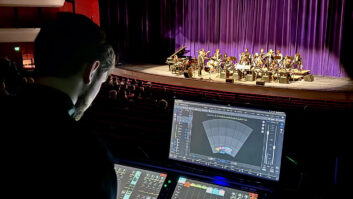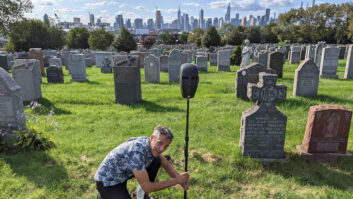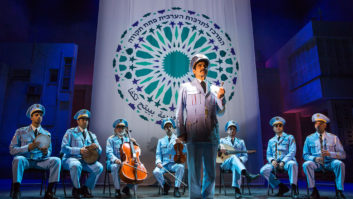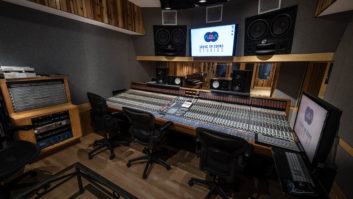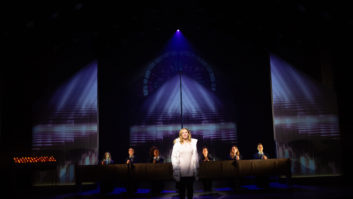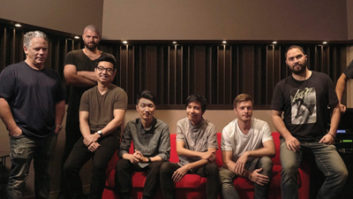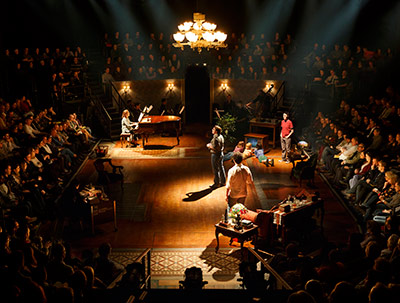
SOUND BYTE
“There’s a reason there aren’t many musicals in-the-round—it’s really difficult to do it well.”—Kai Harada
Fun Home may be the most unlikely smash-hit, rave-reviewed Tony-sweeping Broadway musical yet.
Said to be the first Broadway show about a gay woman, Fun Home is a memory play about 42-year-old cartoonist Alison and her chaotic upbringing. It is also theater magic, most critics agree.
The musical limns Alison’s chaotic small-town Pennsylvania upbringing in the ornate Victorian home her gay father restored obsessively (while also reluctantly running the family funeral parlor and teaching public-school English). He also worked to keep his not-so-secret life from unraveling everything…including his marriage to Alison’s forbearing mother.
Fun Home deftly navigates this rocky terrain with incisive songs and dialog. However, after Alison tells her family she is gay and brings Joan home for an awkward visit, her increasingly troubled father is hit and killed by a truck. Alison sees the apparent accident as a clear case of suicide.
And yes, it’s a musical, with comedy. And Fun Home indeed swept the 2015 Tony Awards, winning five, including the top prize, Best Musical.
The show is based on the best-selling 2006 graphic memoir by cartoonist Alison Bechdel, who won a MacArthur Fellowship in 2014. She emerged nationally in the mid-‘80s with the alternative comic strip Dykes to Watch Out For.

In the Round?
Fun Home further distinguishes itself on the Great White Way as a musical staged rather differently—in-the-round Broadway musicals can be counted on one hand, with fingers likely left over.
Fun Home originated Off Broadway at New York’s Public Theater in 2013, winning a slew of awards. The decision to go from proscenium staging to in-the-round for Broadway was mainly a production choice, says sound designer Kai Harada.
Director Sam Gold—who won the 2015 Tony for Direction—realized that the only way to improve the staging was to go in-the-round, Harada notes. And the smallish Circle in the Square Theatre (New York’s legendary 623-seat room in the basement of a midtown skyscraper) was available.
Harada admits he was, “apprehensive…there’s a reason there aren’t many musicals in-the-round—it’s really difficult to do it well!” Having the stage totally surrounded by the audience meant a complete overhaul.
“It was challenging for all departments, and for the cast, but the show took an incredible leap forward,” says Harada. “Now you really feel you’re part of the family, watching Alison’s past come to life. It is an immersion rather than a presentation.”
In fact, the first few rows surrounding the floor-level stage are intimately close to the action, a scant few feet away, and there is not an obstructed sightline in the room, as the action moves all around the big rectangular stage.
Accordingly, Harada’s sound design worked ambitiously to pull the audience right into the warped and hectic world of Alison and her funeral-home-running, décor-obsessed family, by “making the sound system disappear, so the audience is not listening to the system but to the show.”
Most notably, Harada and his team took the growing trend of sourcing the sound from precise points onstage to a much greater level of complexity. In Fun Home, they’re sourcing the sound from the actors’ constantly moving positions on the big stage for every seat in the wraparound house.
To do this, Harada utilized an Out Board Electronics TiMax2 Soundhub, running 48-in/48-out. The sourcing, or localization effect, is achieved mainly with a multitude of precise crosspoint delay adjustments. (This is known as the Haas effect, in which listeners determine the position of a sound based on which ear perceives it first, and the sound’s successive reflections.) Small amplitude tweaks were also used.
The team arrayed the 50 Meyer Sound fill speakers used for the sourcing effect on Circle in the Square’s two catwalk ovals (inner and outer), five to ten feet apart, explains associate sound designer Stephanie Celustka.
However, this was not a simple matter of sourcing the sound from a few key stage positions. The show has 27 distinct onstage areas where key dialog/singing occurs (the zones). Creating the sourcing impression for 27 onstage zones for every seat in a wraparound house was a major undertaking.
“For every onstage zone, each one of the 50 speakers had to have an individual relationship, both in delay time and output level,” Celustka explains. “50 by 27, that’s a lot of information in the program!” she emphasizes.
Harada did all the planning and pre-production work on the sourcing approach, and then it was up to Celustka to program the TiMax system, he says.
“There was a lot of math and science involved in the early stages, and then a lot of listening in the later stages,” Celustka explains.
It was a slow, methodical process of first using a formula designed to calculate delay times based on the distance of a speaker from the source (the actors) and the speed of sound, and inputting those calculations to the system. “Of course the math said one thing, and during tech when we were listening to music and speech over the system, I’m hearing something else,” Celustka notes wryly.
During tech quiet time they played music over the system, and for speech testing an audio assistant took to the stage wearing an RF mic. “She would read from a book, or tell us about her day,” Celustka notes with a laugh.
“We then adjusted the measurements based on the reality of the relationship of the speakers to the various stage zones, as heard in the house, using Meyer Sound’s SIM3 and Rational Acoustics’ Smaart software and measurement mics,” Celustka explains. “Kai would also go from seat to seat during tech rehearsals to get a feel for the sound.” Setup took two to three weeks of full tech days.

“Then, during preview performances, Kai would sit in a different location each night so he could experience as many vantage points as possible, in a true show setting,” Celustka says. “We continued to make fractional-millisecond to full-millisecond crosspoint delay changes to speakers throughout the tech and preview process, allowing the sourcing to really take shape.”
The crosspoint delays ultimately used to create the sourcing effect went as high as nearly 60 milliseconds, while amplitude changes were only 1-2 dB, Celustka adds.
The 50 (out of the 112 total) speakers used for the audio sourcing included Meyer UPJuniors, UPM-1Ps, MM-4s and M1Ds.
While the sourcing draws the audience into the drama, it also helps eliminate distractions. Without this sophisticated level of audio sourcing, “There would be hot spots, it would sound louder in places and a lot less natural, more amplified. Also, you would hear an echo from the other side of the room if an actor was really close to you…and it would sound wrong,” Harada explains.
However, it works seamlessly. The sound is natural and seemingly un-amplified, and the complex sourcing goes masterfully with the in-the-round staging, creating the convincing effect that one is hearing the actors naturally project from whatever part of the big stage they’re on.
As intended, it dials up the intimacy.
Foldback needs were simplified by the orchestration of the seven-piece band. “Because the show is so brilliantly written and orchestrated, we didn’t need to worry about monitoring that much. If the orchestration were fuller, with less of a chamber-music quality, foldback would be a bigger concern, but Fun Home is written to have enough space for vocals and beautiful music behind it,” says Harada.
For actors to hear themselves and each other on the big rectangular space that is roughly twice the size of a typical Broadway stage, they’re simply relying on the main system bouncing back. “We were concerned; could an actor hear dialog from the extreme ends of house? But it was never a problem,” notes Harada.
In fact, eight slots were designed into the stage floor for monitors, “But we didn’t need them for hearing dialog, so we used those speakers for sound effects,” Harada notes.
“I have strong feelings about not putting vocal foldback onto the stage,” Harada says. “By the time you get it loud enough so the actors can hear it, you’ve created a feedback loop; their mic is hearing it as their ears are, creating nasty comb filtering and ruining the experience for the audience.”
A proscenium stage always needs more foldback so the pit band can be heard onstage, but most of the Fun Home band is onstage with the actors (a few pieces are offstage and unseen; the band has in-ear Aviom monitors).
Harada hid four big Meyer UPQ speakers up above the band and Meyer UPJ-1P and UPJunior speakers near the band, to push the music right out onto the stage. The UPQs are mainly what the audience hears, “and they have a calm way of dispersion—they trail off in a nice natural-sounding way,” says Harada.
“That’s the same reason we use the Studer Vista 5 console, it has a very transparent sound,” he notes.
The monitor system is nearly all fill-size Meyer Sound speakers. “This is a huge fill system with a lot of little speakers and no center cluster,” Harada says. Being in the round, and the “precise, focused nature of the audio approach dictated using fill speakers, not a huge central system.” Another factor in using mostly smaller fill speakers was the intimacy of the show. “With the audience so close to actors, I did not want them thinking about the sound system, so the less they can see speakers, the better,” Harada explains.
Mixer Patrick Pummill is another key to the show’s seamlessly natural sound, Celustka says. Pummill “has amazing ears, and without his talent we might under-hear or over-hear the system.” Harada concurs that Pummill “has an incredibly musical ear; I try to get him for every show I design. I never have to give him mixing notes. We hear similarly, so I am not trying to second guess what the mixer is doing.”
Another factor in creating the audio intimacy that in part powers Fun Home has nothing to do with audio gear. It is the use of quiet, fan-free LED theater lighting. “None of the main stage lighting has fans; there are just a few moving lights with fans,” says Harada.
“Cooling fans make incandescent systems so loud, and on Fun Home the lighting is so close to audience and actors. Fans would create a huge amount of stage noise, and the audience is so close it would be distracting. The noise also gets into the mics, amplifying it every time you turn on a mic, but lighting designer Ben Stanton took a leap with LED-based instruments, and the results are amazing,” he adds.
As complex as the sound design for Fun Home in the round was, the ambitious approach was made somewhat easier because Harada did the sound for the Off-Broadway run. “One of the benefits of doing Fun Home for Broadway was that we’d done it before. That gave me a bit more comfort. If I’d done it from scratch I think it would’ve been much more difficult.”
However, Harada also credits the producers for their trust in realizing his sound design. “I warned them in our initial meeting: We need a lot of small speakers everywhere, and absolutely needed the TiMax system to do a successful sound design in the round. I appreciate that between equipment-provider Masque Sound, the producers and myself we came up with a system that fulfilled the needs of the show and worked within the budget. I couldn’t be prouder of what we’ve accomplished.”
